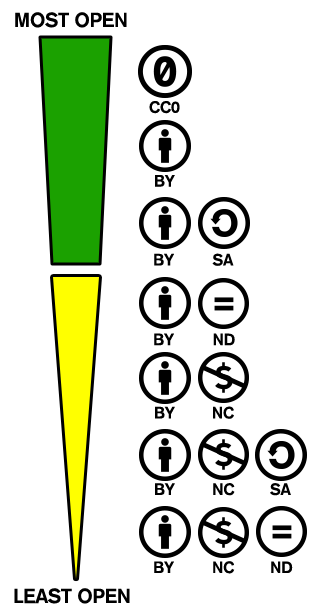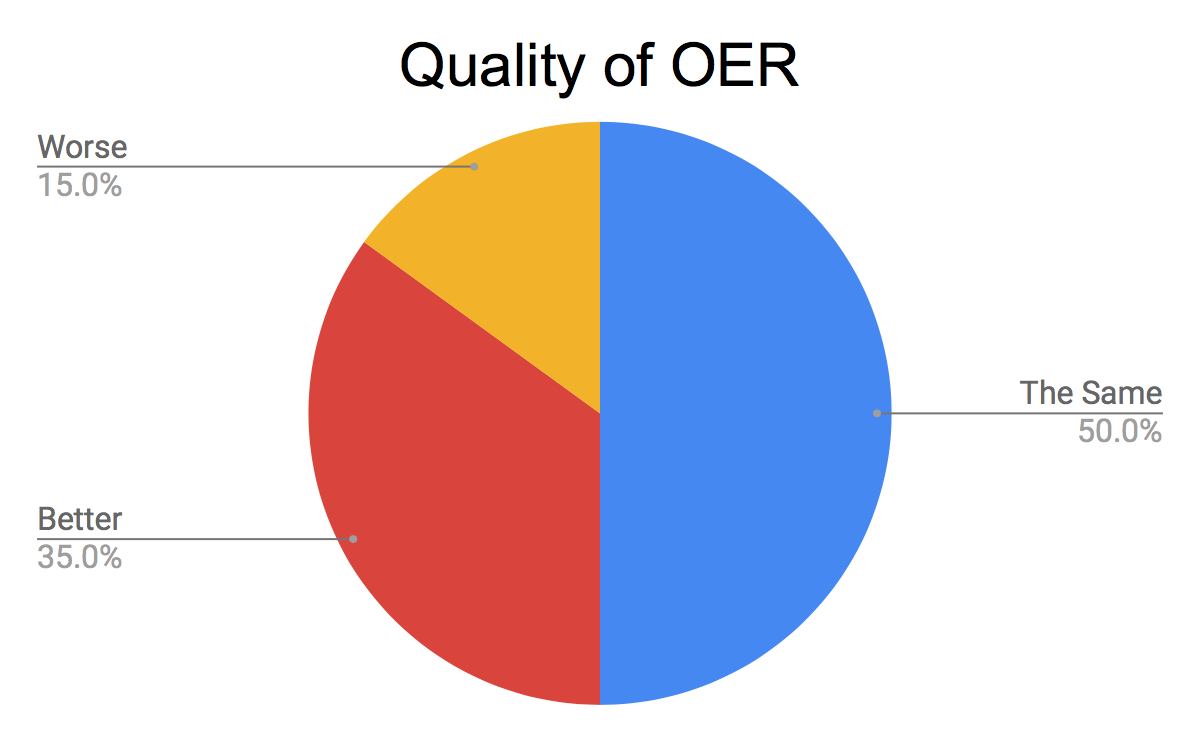Why Open?
There are numerous reasons to consider open educational resources and affordable learning alternatives.
The Freedom to Adapt
One of the strongest benefits of adopting an open textbook is the ability to remix the textbook to more closely align with the learning objectives of a course. Almost all open textbooks rely on Creative Commons licensing as the basis for allowing specific rights to be granted to another individual.
 The term “open content” describes any copyrightable work (traditionally excluding software, which is described by other terms like “open source”) that is licensed in a manner that provides users with free and perpetual permission to engage in the 5R activities:
The term “open content” describes any copyrightable work (traditionally excluding software, which is described by other terms like “open source”) that is licensed in a manner that provides users with free and perpetual permission to engage in the 5R activities:
- Retain — the right to make, own, and control copies of the content (e.g., download, duplicate, store, and manage)
- Reuse — the right to use the content in a wide range of ways (e.g., in a class, in a study group, on a website, in a video)
- Revise — the right to adapt, adjust, modify, or alter the content itself (e.g., translate the content into another language)
- Remix — the right to combine the original or revised content with other open content to create something new (e.g., incorporate the content into a mashup)
- Redistribute — the right to share copies of the original content, your revisions, or your remixes with others (e.g., give a copy of the content to a friend).(1)
While a particular open textbook may not satisfy 100% of the stated learning objectives of a course, it is very possible to remix multiple open texts into a new book that more closely aligns to the needs of the instructor
Affordability
It has been identified in numerous studies that cost is one of the main factors in determining whether a student decides to purchase or not purchase the required materials for a course. A recent Florida Virtual School Survey (2) surveyed 22,000 students and found that due to textbook cost:

There are numerous considerations that factor into the rising cost of higher education, but the one area that faculty can have the most impact is the cost of materials. eTextbooks might seem like the easiest answer, but it’s important to remember that most major publishers who offer an eText version will only allow students access to the text for 180 days on average. This makes building a library of resources difficult for students.
Quality
While open educational resources and open textbooks have been available for many years, the perception of quality has always been a cause for concern. However, in recent years, many open textbook providers are now including rating systems that allow for peer review, thus providing an opportunity for subject matter experts to weigh in on a range of criteria, including:
- Comprehensiveness - The text covers all areas and ideas of the subject appropriately and provides an effective index and/or glossary.
- Content Accuracy - Content is accurate, error-free and unbiased.
- Relevance Longevity - Content is up-to-date, but not in a way that will quickly make the text obsolete within a short period of time. The text is written and/or arranged in such a way that necessary updates will be relatively easy and straightforward to implement.
- Clarity - The text is written in lucid, accessible prose, and provides adequate context for any jargon/technical terminology used.
- Consistency - The text is internally consistent in terms of terminology and framework.
- Modularity - The text is easily and readily divisible into smaller reading sections that can be assigned at different points within the course (i.e., enormous blocks of text without subheadings should be avoided). The text should not be overly self-referential, and should be easily reorganized and realigned with various subunits of a course without presenting much disruption to the reader.
- Organization Structure Flow - The topics in the text are presented in a logical, clear fashion.
- Interface - The text is free of significant interface issues, including navigation problems, distortion of images/charts, and any other display features that may distract or confuse the reader.
- Grammatical Errors - The text contains no grammatical errors.
- Cultural Relevance - The text is not culturally insensitive or offensive in any way. It should make use of examples that are inclusive of a variety of races, ethnicities, and backgrounds.(3)
On our research page, you will find numerous published articles and studies that discuss the quality of open resources. In terms of student and teacher perceptions of OER, 2,717 students and 2,484 faculty members were surveyed across the nine peer-reviewed studies.
Approximately 50% said that the OER resources were as good as traditional resources, 35% said the OER were superior and 15% said they were inferior.

Accessibility
The open format has fewer restrictions regarding printing, copy and pasting, sharing, and re-sizing—to name a few—which means that these resources support assistive learning for students who need accommodation. Most open textbooks ensure that proper heading tags, alternative text for images, descriptive text for links, and charts and graphs are built to ensure that screen readers can easily navigate and understand the text.
Improved Student Outcomes
Across 13 academic studies that attempted to measure results pertaining to student learning (higher ed: 15784 treatment, 99,692 control, k12: 1805 treatment 2439 control) none showed results in which students who utilized OER performed worse than their peers who used traditional textbooks.
95% Same or Better outcomes.
Active Learning
Since most open textbooks are provided in a digital format, the inclusion of multimedia elements are included. “The digital format offers a variety of methods for increasing in the moment learning including “mouse overs” (e.g., definitions pop up on screen), ‘adaptive learning’ (tests embedded in the chapter that track individual student performance and adapt to it), and hyperlinks to related videos and readings.”(4)
What is happening with Open in our region?
The Midwestern Higher Education Compact (MHEC) released a report in March 2019 about college textbook affordability. This MHEC report details the major issues with textbook affordability, some of the possible solutions (e.g., OER, inclusive access, etc.), and gives a summary of the current status of the Open movement in the Midwest.
Notes:
- Retrieved from http://opencontent.org/definition/ on February 28, 2018.
- Florida Virtual Campus. (2016). 2016 Florida Student Textbook Survey. Tallahassee, FL.
- This rubric was developed by BCcampus. This work is licensed under a Creative Commons Attribution 3.0 Unported license.
- Diener, E, Diener, C and Biswas-Diener, R. 2017. Open-Source for Educational Materials Making Textbooks Cheaper and Better. In: Jhangiani, R S and Biswas-Diener, R. (eds.) Open: The Philosophy and Practices that are Revolutionizing Education and Science. Pp. 209–217. London: Ubiquity Press. DOI: https://doi.org/10.5334/bbc.p. License: CC-BY 4.0
Citations:
- Biswas-Diener, R. and Jhangiani, R. S. (eds) (2017) Open: The Philosophy and Practices that are Revolutionizing Education and Science. London: Ubiquity Press. DOI: https://doi.org/10.5334/bbc
- Diener, E, Diener, C and Biswas-Diener, R. 2017. Open-Source for Educational Materials Making Textbooks Cheaper and Better. In: Jhangiani, R S and Biswas-Diener, R. (eds.) Open: The Philosophy and Practices that are Revolutionizing Education and Science. Pp. 209–217. London: Ubiquity Press. DOI: https://doi.org/10.5334/bbc.p. License: CC-BY 4.0
